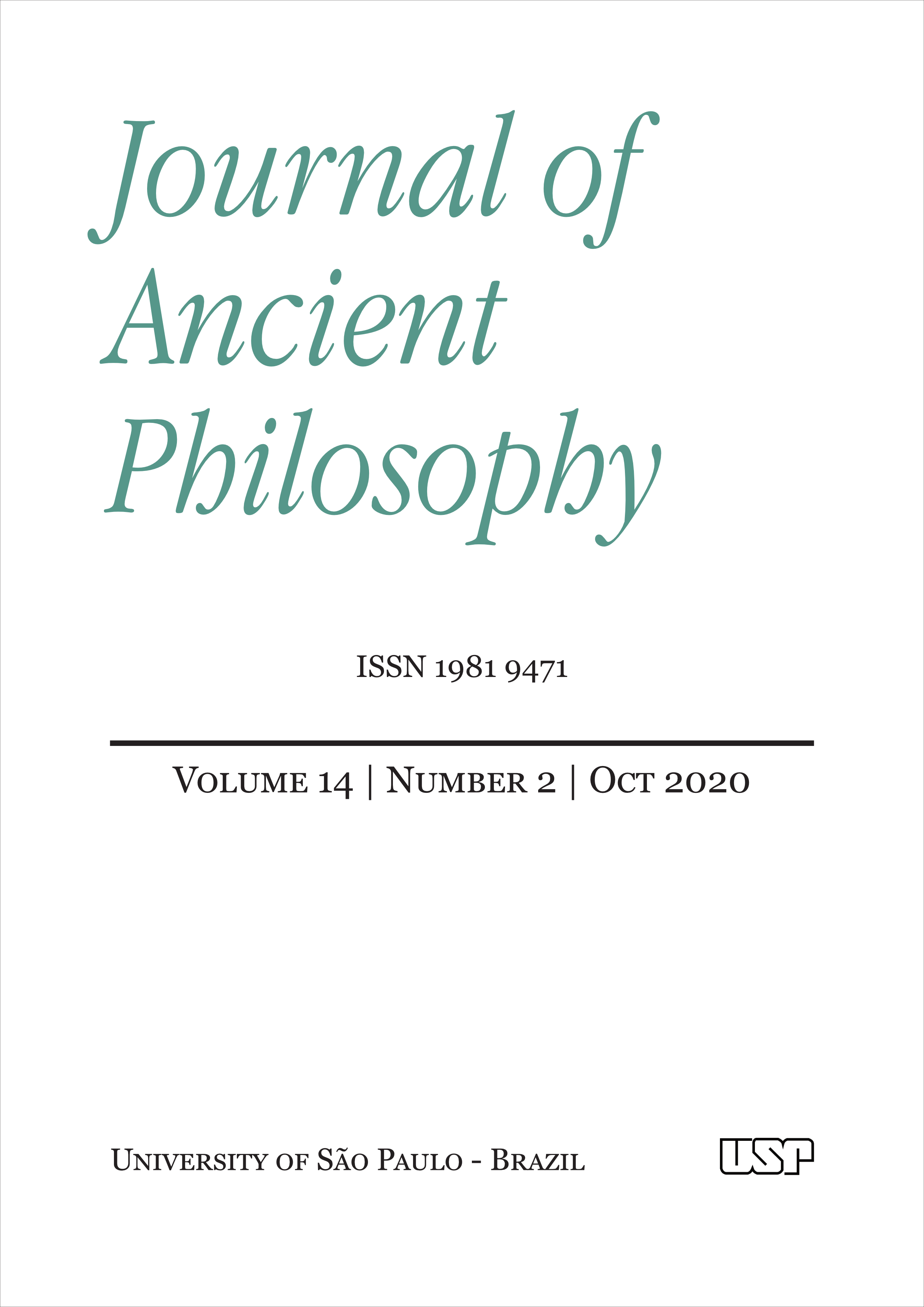Aristotle’s Methodology for Natural Science in Physics 1-2: a New Interpretation
DOI:
https://doi.org/10.11606/issn.1981-9471.v14i2p130-146Keywords:
Aristotle, physics, method, knowledgeAbstract
In this essay I will argue for an interpretation of the remarks of Physics 1.1 that both resolves some of the confusion surrounding the precise nature of methodology described there and shows how those remarks at 184a15-25 serve as important programmatic remarks besides, as they help in the structuring of books 1 and 2 of the Physics. I will argue that “what is clearer and more knowable to us” is what Aristotle goes on to describe in 1.2—namely, that nature exists and that natural things change—his basic starting-point for natural science. This, I shall hope to show, is the kind of “immediate” sense datum which Aristotle thinks must be further analyzed in terms of principles (archai) and then causes (aitia) over the course of Physics books 1 and 2 to lead to knowledge about the natural world.[1] Such an analysis arrives at, as I shall show, a definition (horismos) of nature not initially available from the starting-point just mentioned (i.e., it is in need of further analysis), and which is clearer by nature.[2] It is not my aim here to resolve longstanding debates surrounding Aristotle’s original intent in the ordering and composition of the first two books of the Physics, nor how the Physics is meant to fit into the Aristotelian corpus taken as a coherent whole, but rather to show that the first two books of the Physics, as they stand, fit with the picture of methodology for natural science presented to us in 1.1.
[1] An interesting consequence of this, and one which I shall not pursue in this paper at any length, is that the progression from what is clearer to us and what is clearer by nature is by necessity a form of revision: i.e., the Physics should not be seen as a work validating the “starting-point” of 1.2 contra the monists, but a work which gradually builds to the language of matter and form as what is clearer by nature.
[2] Viz., what we find at the beginning of 2.1: “this suggests that nature is a sort of source (arche) and cause (aition) of change and remaining unchanged in that to which it belongs primarily of itself, that is, not by virtue of concurrence” (192b20-22).
Downloads
References
Aristotle (1984). The Complete Works of Aristotle. Vols. 1 and 2. Princeton: Bollingen.
Aristotle (1983). Physics: Books I and II. Trans. W. Charlton. Oxford: Clarendon, 1983.
Bolton, Robert (1988). “Aristotle’s Method in Natural Science: Physics I.” Aristotle’s Physics: A Collection of Essays. Ed. Lindsay Judson. Oxford: Clarendon.
Cleary, John (1994). “Phainomena in Aristotle’s Philosophic Method.” International Journal of Philosophical Studies, 2: 61–97.
Hankinson, R. J. (1995) “Philosophy of Science” and “Science.” The Cambridge Companion to Aristotle. Ed. Jonathan Barnes. Cambridge: Cambridge.
Irwin, Terence (1988). Aristotle’s First Principles. Oxford: Clarendon.
Kelsey, Sean (2003). “Aristotle’s definition of nature.” Oxford Studies in Ancient Philosophy 25: 59-87.
Lennox, James (2008). “‘As if we were investigating snubness’: Aristotle on the prospects for a single science of nature.” Oxford Studies in Ancient Philosophy 35: 149-186.
Owen, G. E. L. (1962/1986) Logic, Science, and Dialectic. London and Ithaca: Cornell University Press.
Ross, W. D. (1936) Aristotle’s Physics: A revised text with introduction and commentary. Oxford: Clarendon.
Ross. W.D. (1962) “Philosophy of nature.” Aristotle: A complete exposition of his works and thought. Cleveland: Meridian.
Simplicius (1997). On Aristotle’s Physics 2. Trans. Barrie Fleet. Ithaca: Cornell University Press.
Themistius (2012). On Aristotle’s Physics 1-3. Trans. Robert B. Todd. Ithaca: Cornell University Press.
Waterlow, Sarah (1988). Nature, Change, and Agency in Aristotle’s Physics. Oxford: Clarendon.
Downloads
Published
Issue
Section
License

This work is licensed under a Creative Commons Attribution 4.0 International License.
Copyright
Authors who publish with this journal agree to the following terms:
- Authors retain copyright and grant the journal right of first publication with the work simultaneously licensed under a Creative Commons Attribution License (CC By 4.0) that allows others to share the work with an acknowledgement of the work's authorship and initial publication in this journal.
- Authors are able to enter into separate, additional contractual arrangements for the non-exclusive distribution of the journal's published version of the work (e.g., post it to an institutional repository or publish it in a book), with an acknowledgement of its initial publication in this journal.
- Authors are permitted and encouraged to post their work online (e.g., in institutional repositories or on their website) prior to and during the submission process, as it can lead to productive exchanges, as well as earlier and greater citation of published work (See The Effect of Open Access).


